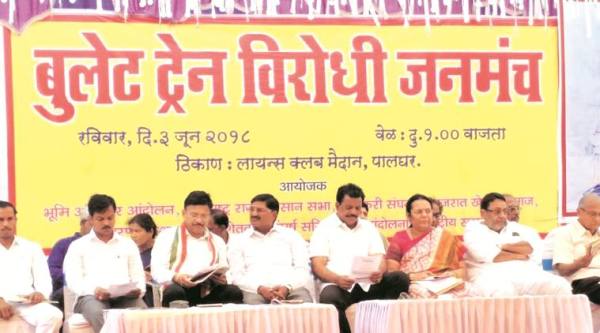 Opposition leaders had assembled in Palghar last month to protest against the project. (Express Archive)
Opposition leaders had assembled in Palghar last month to protest against the project. (Express Archive)
With the Godrej group moving the Bombay High Court against the proposed acquisition of a 3.5-hectare plot for the Mumbai-Ahmedabad bullet train project and offering a piece of land adjacent to the plot earmarked for acquisition, the National High Speed Railway Corporation Limited (NHSRCL), which is implementing the project, is carrying out technical assessment of the offer from the conglomerate.
The 3.5 hectare plot is part of the land requirement for the 508-km high-speed corridor’s alignment. The NHSRCL wants to use this land to drill a shaft to access an underground tunnel that it will build to connect Vikhroli with the Bombay-Kurla Complex, where the underground station will be located.
Boyce Manufacturing Limited, a Godrej group company, moved the Bombay High Court in May, challenging the proposed acquisition of its prime property for the bullet train project. Last month, Godrej approached the high court with an offer to give another piece of land about 250 m away from the currently-earmarked site. The company has claimed that the original site has its warehouse and that it has expansion plans there, so it was willing to give an adjacent land up for acquisition as per the Land Acquisition Act.
In the first hearing in the matter on June 19, the counsel for the railways told the court that “some proposal in respect of the alternate land is likely to be received from the petitioner. For the same purpose, both the parties pray for six weeks’ time.” The court has posted the matter on July 31 and the NHSRCL wants to present the technical feasibility report to the court on that day.
But for NHSRCL, there are three considerations to be made before its accepts the offer — technical feasibility, cost, and status of the alternate site. According to NHSRCL, the alternate site is engaged in long-standing litigation with the state-government, an encumbrance the project company does not want to inherit. It wants the high court to give clear directions on the matter.
NHSRCL Managing Director Achal Khare has instructed the Japanese team working on the design of the project to assess the technical feasibility of the alternate site as well as the cost involved in the shift. Officials in NHSRCL told The Indian Express that in either case, the original alignment of the corridor will not be altered. The shaft is needed to make way for equipment to build the corridor’s tunnel, whose location remains the same.
“If the technical feasibility indicates that it cannot be done or that it escalates the project cost, then we will not be interested. Moreover, we do not want to take land tied up in litigation,” said a senior NHSRCL official who did not want to be quoted since the matter is sub-judice. The company will be seeking directions on the status of the alternate site from the court, he said. The alternate site also has some mangroves where any project work requires the high court’s permission, on which, too, the project company will seek directions.
Godrej executives did not want to comment on the matter, but NHSRCL officials said the company has not made any monetary demand for the original land and has merely offered another site.
“We plan to explore options through which we can amicably solve the issue,” said Rajinder Singh, Mumbai project manager of NHSRCL.
Starting work on acquiring land around December last year, the project has met with resistance from farmers in Maharashtra’s Palghar and Dahanu as well as Surat in Gujarat. It has so far completed Joint Measurement Survey — to ascertain exact coordinates of the land and who are the title holders — in 102 of the 508 km of the corridor. Around 50 km of the 102 km is in Gujarat, while the rest is in Maharashtra. The project requires 7,000 plots of land in two states.